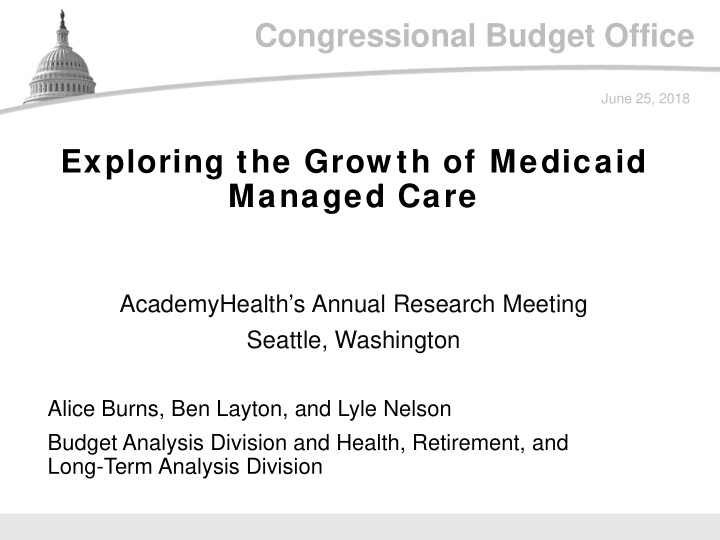



Congressional Budget Office June 25, 2018 Exploring the Grow th of Medicaid Managed Care AcademyHealth’s Annual Research Meeting Seattle, Washington Alice Burns, Ben Layton, and Lyle Nelson Budget Analysis Division and Health, Retirement, and Long-Term Analysis Division
CBO Medicaid is a federal-state program that provides health benefits to 70 million low-income individuals. In fiscal year 2015, it accounted for $348 billion in federal spending and $205 billion in state spending. 1
CBO States typically use two payment systems to provide Medicaid benefits: Fee-for-service (FFS), and Managed care. 2
CBO Why would states adopt managed care? To make spending for Medicaid more predictable, or To improve the coordination of care, which may reduce costs or improve outcomes. 3
CBO Managed Care’s Enrollment Rate and Share of Medicaid Spending Percent 4
CBO Changes in the Share of Medicaid Spending Attributable to Managed Care, 1999 to 2014 5
CBO CBO examined these questions: To what extent does managed care deliver Medicaid services? How and why has managed care grown in recent years? 6
CBO A major challenge to understanding the growth of managed care is the variation in states’ programs and the lack of systematic data. CBO constructed, and will soon publish, a new dataset to make comparing states’ Medicaid managed care programs easier. 7
CBO What Types of Managed Care Plans Are Beneficiaries Enrolled in? 8
CBO CBO used Medicaid Analytic eXtract data on beneficiaries’ spending and enrollment from 1999 to 2012 (the most recent year for which data were available). Only data for beneficiaries who were eligible for full Medicaid benefits were analyzed. 9
CBO Types of Managed Care Organizations (MCOs) Comprehensive MCOs: General comprehensive Long-term services and supports The Program of All-inclusive Care for the Elderly (PACE) Noncomprehensive MCOs: Behavioral Dental Case management “Other” 10
CBO Medicaid Beneficiaries, by Type of Enrollment, 2012 Millions of Beneficiaries 11
CBO Rates of Enrollment in Managed Care and Fee-for-Service Medicaid, by Eligibility Group, 2012 Percent 12
CBO Why is Spending on Managed Care Less Than Spending on FFS? 13
CBO Total Medicaid Spending, by Category, 2014 Billions of Dollars a. Comprises Medicaid spending and rebates that do not correspond to any particular beneficiary, such as supplemental payments to providers and prescription drug rebates; those amounts are not included in the data on Medicaid beneficiaries. 14
CBO Average Monthly Spending on Managed Care and Fee-for-Service Medicaid, by Enrollment, 2012 Dollars 15
CBO Managed Care’s Enrollment Rate and Share of Medicaid Spending Percent 16
CBO Managed Care’s Enrollment Rate and Share of Medicaid Spending (Continued) Percent 17
CBO FFS Spending for Comprehensive Managed Care Enrollees Who Were Nonelderly and Nondisabled, 2012 Millions of Dollars Figure shows spending for nonelderly, nondisabled adults and children who were enrolled in comprehensive managed care for their entire period of eligibility. 18
CBO FFS Spending for Comprehensive Managed Care Enrollees Who Were Elderly, Disabled, or Also Enrolled in Medicare, 2012 Millions of Dollars Figure shows spending for elderly and disabled beneficiaries and beneficiaries also enrolled in Medicare who were enrolled in comprehensive managed care for their entire period of eligibility. 19
CBO How Has States’ Use of Medicaid Managed Care Changed Over Time? 20
CBO Number of States With Managed Care Programs, by Type of Program a. The Centers for Medicare & Medicaid Services did not collect data on PACE programs as part of its tracking of managed care programs in 1999, but the agency has done so since at least 2005. 21
CBO Number of States With General Comprehensive Managed Care Programs, by Coverage Area 22
CBO Number of States With Mandatory Enrollment in General Comprehensive Managed Care Programs, by Eligibility Group 23
CBO Number of States With General Comprehensive Managed Care Programs, by Services Covered 24
CBO Key Takeaw ays 25
CBO Plan design matters. Both enrollment in and spending on Medicaid managed care grew rapidly from 1999 to 2014, even though the number of states with general comprehensive managed care programs declined over that period. That discrepancy reflects the increasing scope of states’ contracts with MCOs. 26
CBO Data matters. By making it possible to compare states’ managed care programs and changes in those programs over time, CBO’s dataset provides a more nuanced perspective on the growth of managed care. Such data will improve future research and inform expectations about the future of Medicaid managed care. 27
Recommend
More recommend